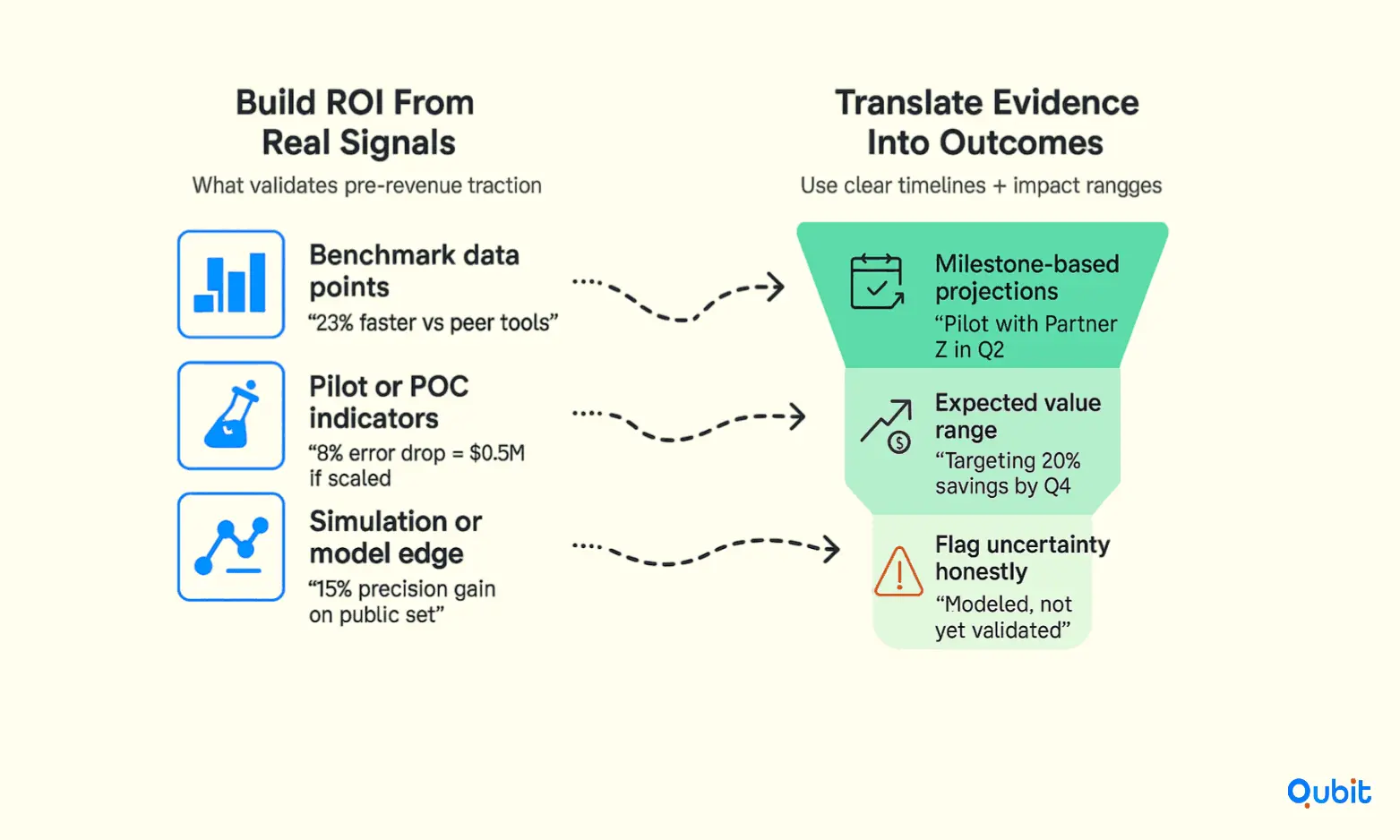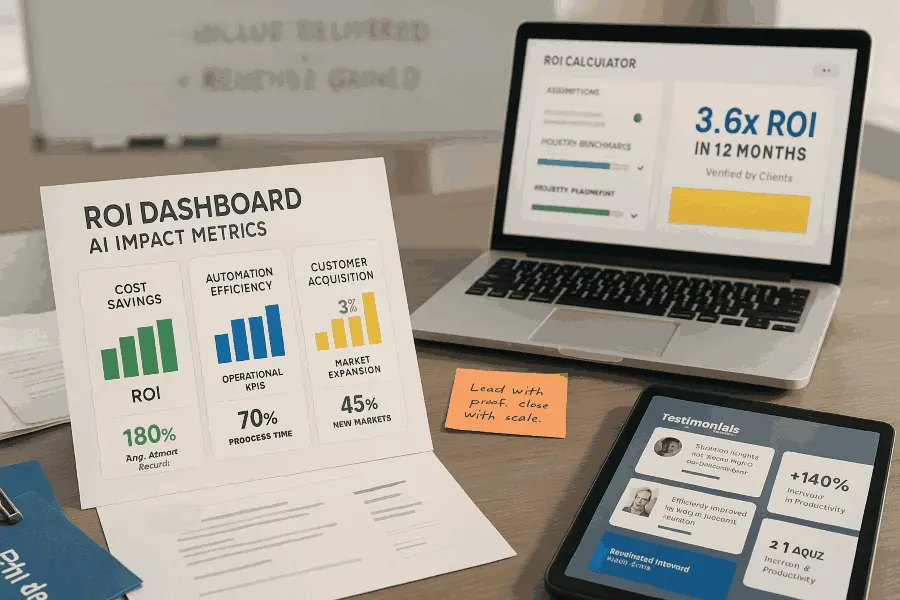Securing funding for an AI startup often hinges on proving its return on investment (ROI). Investors are increasingly drawn to the AI sector, which is projected to reach a staggering USD 757.58 billion by 2025, highlighting its explosive growth and potential. However, showcasing ROI is more than just numbers, it’s about crafting a compelling narrative that aligns with market trends and investor expectations.
Your ROI analysis aligns with broader fundraising perspectives found in how to raise money for AI startup, which contextualizes financial performance within overarching investment strategies.
This blog will explore how AI startups can quantify their impact effectively, leveraging market insights and strategic storytelling to secure funding. Let’s jump right in!
Defining and Measuring AI ROI
Understanding the return on investment (ROI) for artificial intelligence (AI) initiatives requires a balanced evaluation of both tangible and intangible benefits. Tangible benefits, such as cost savings and revenue growth, are often the most immediate indicators of success. For example, AI can automate repetitive tasks, reducing operational costs, or optimize marketing strategies to drive higher sales. On the other hand, intangible benefits like enhanced innovation and improved decision-making processes play a crucial role in long-term growth. These intangible gains often manifest as increased agility in responding to market trends or the ability to uncover new business opportunities through advanced analytics.
Trending vs. Realized Returns
AI ROI can be measured through two distinct approaches: trending returns and realized returns. Trending returns focus on predictive metrics, such as projected cost reductions or anticipated revenue increases based on AI adoption. These metrics help startups gauge the potential impact of their AI solutions before full implementation. Realized returns, however, are grounded in actual outcomes, such as measurable profit growth or confirmed efficiency improvements post-deployment. Combining these approaches allows businesses to not only forecast their AI-driven success but also validate it with concrete results.
Why AI Startups Excel
AI startups often outperform their non-AI counterparts, achieving up to 2.5× higher success rates. This advantage stems from their ability to enter markets quickly and attract customers at lower acquisition costs. By leveraging AI-driven tools, startups can streamline processes, reduce time-to-market, and deliver personalized experiences that resonate with target audiences. These factors collectively contribute to higher scalability and profitability.
Your discussion of ROI is complemented by the detailed budgeting strategies in AI startup use of funds budgeting for investors, offering a closer look at how fund allocation supports financial demonstrations.
Identifying Key Metrics and Quantifying AI Impact
Measuring the impact of AI initiatives is essential for startups aiming to demonstrate value to investors. Establishing clear metrics ensures that both immediate results and long-term benefits are visible. The process begins with defining robust pre-project baselines, which serve as benchmarks for evaluating progress. Without these baselines, it becomes challenging to quantify the improvements brought by AI solutions.
Establishing Pre-Project Baselines
Startups should focus on identifying key performance indicators (KPIs) that align with their business goals. For example, an e-commerce startup might track metrics like conversion rates, customer acquisition costs, or average order value. These metrics provide a snapshot of the current state before implementing AI. By documenting these figures, startups can later compare them to post-project outcomes, highlighting the tangible benefits of AI integration.
Tracking Post-Project Improvements
Once AI solutions are deployed, tracking changes in the identified KPIs becomes critical. For instance, if a startup uses AI to optimize its marketing campaigns, metrics such as click-through rates or return on ad spend (ROAS) can reveal the effectiveness of the AI-driven strategies. Beyond immediate results, startups should also monitor long-term impacts, such as customer retention rates or operational efficiency gains.
Demonstrating Strategic Value
Investors are not only interested in short-term wins but also in the strategic value AI brings to a startup. Metrics that showcase scalability, such as the ability to handle increased customer demand or reduce costs as the business grows, can be particularly compelling. These insights help build a narrative that connects performance metrics to broader business objectives. You can see a direct connection to investor confidence in AI startup investor traction metrics narrative, where performance metrics and narrative elements are discussed to reinforce funding appeal.
By quantifying AI's impact through carefully chosen metrics, startups can effectively communicate their value proposition to investors. This approach not only highlights immediate improvements but also underscores the potential for sustained growth and innovation.
Estimating and Calculating AI ROI
Understanding the return on investment (ROI) for artificial intelligence (AI) initiatives requires a structured approach. To ensure accurate forecasting and calculation, businesses must focus on three key areas: defining cost inputs, quantifying benefits, and determining net returns.
Step 1: Define Cost Inputs
The first step in calculating AI ROI is identifying all associated costs. These include upfront expenses such as software development, hardware acquisition, and licensing fees, as well as ongoing costs like maintenance, training, and operational adjustments. Capturing these details ensures a comprehensive view of the financial commitment required for the AI project.
Step 2: Quantify Benefits
Quantifying the benefits of AI involves assessing measurable outcomes, such as increased efficiency, reduced operational costs, or enhanced customer satisfaction. For example, AI-powered automation might reduce manual labor hours, while predictive analytics could improve decision-making accuracy. Establishing historical baselines—such as pre-AI performance metrics—helps compare outcomes and validate the impact of AI implementation.
Step 3: Determine Net Returns
Once costs and benefits are defined, calculating net returns becomes straightforward. Subtract total costs from total benefits to determine the financial gain or loss. This calculation provides a clear picture of whether the AI initiative is delivering value.
Standardized Tools for Consistency
To streamline the process, businesses can use standardized tools like the AI ROI Calculation. This framework simplifies ROI calculations by guiding users through mapping costs, forecasting benefits, and calculating net returns step by step. Using such tools ensures consistency and builds confidence when presenting ROI data to stakeholders or investors.
Why Historical Baselines Matter
Historical baselines are critical for evaluating AI ROI. They provide a point of comparison, enabling businesses to measure improvements accurately. Without these benchmarks, it becomes challenging to attribute gains directly to AI implementation.
By following this systematic approach and utilizing tools like the AI ROI Calculation Template, businesses can confidently forecast and calculate AI ROI, ensuring their investments align with strategic goals.
Challenges, Best Practices, and Sustaining AI ROI
Achieving consistent ROI from AI initiatives often requires overcoming significant hurdles. Common challenges include inconsistent data quality, integration complexities, and the experimental nature of AI projects. These issues can hinder progress and dilute the potential benefits of AI investments.
Key Challenges in AI ROI
Data Quality and Consistency
Poor data quality remains a major obstacle for organizations attempting to scale AI. Inconsistent, incomplete, or unstructured data can lead to unreliable insights and inaccurate predictions. Without a robust data management strategy, AI models may fail to deliver meaningful results.Integration Complexities
Integrating AI systems with existing workflows and legacy technologies can be daunting. Compatibility issues often arise, requiring significant time and resources to resolve. This can delay implementation and reduce the overall efficiency of AI solutions.Experimental Nature of AI
Many AI initiatives operate in uncharted territory, making them inherently experimental. This unpredictability can result in projects that fail to meet expectations or require frequent adjustments, which can inflate costs and reduce ROI.
Best Practices for Sustaining AI ROI
Establish Clear Baselines
Begin by defining measurable goals and benchmarks for your AI projects. Establishing clear baselines ensures that progress can be tracked effectively and provides a framework for evaluating success.Continuous Tracking and Optimization
AI systems require ongoing monitoring to ensure they remain aligned with business objectives. Regular performance reviews and adjustments can help optimize outcomes and sustain ROI over time.Align AI Initiatives with Business Goals
Successful AI projects are those that directly support broader organizational objectives. By ensuring alignment, businesses can maximize the impact of AI investments and avoid wasted resources on initiatives that lack strategic relevance.
Visualize ROI in Your Pitch Deck
Use clear, investor-friendly visuals:
- Before/After Graphs: Show how KPIs improved post-AI implementation.
- ROI Waterfall Charts: Break down sources of cost saving, new revenues, efficiency, risk reduction.
- Payback Timeline: Indicate time to positive ROI (“Break-even achieved after 7 months in paid pilot.”)
- Testimonials: Where possible, display a concise quote from a real customer or partner.
- Comparative Table: If you serve different industry segments, show typical KPI lift for each.
Early-Stage Startups: Building a Credible ROI Story Without Big Wins
If you’re pre-revenue or pre-launch, your job is to ground projected ROI in credible industry metrics, pilot data, or simulation results. For example:

- Reference published benchmarks: “Peer-reviewed studies show a median 23% reduction in process time with similar AI tools.”
- Highlight pilot/POC indicators: “Our POC yielded an 8% error reduction in a controlled test with $0.5M in potential annualized savings if scaled to all facilities.”
- Lean on early adopter feedback, simulation, or technical superiority: “Our AI model demonstrated 15% better precision on public benchmarks, indicating potential for cost savings as shown in peer deployments.”
Be transparent that these are projections, and outline a clear milestone (e.g., “Pilot with Partner Z commencing Q2, on track to validate predicted 20% savings by Q4”).
A Qubit Capital Solution
At Qubit Capital, we specialize in helping organizations overcome these challenges and implement best practices to achieve sustainable AI ROI. Whether you're struggling with data quality or integration issues, our tailored solutions ensure your AI initiatives deliver measurable results.
Conclusion
Throughout this blog, we’ve explored key strategies for effectively showcasing AI ROI, emphasizing the importance of a clear, narrative-driven approach. By aligning your AI solutions with tangible business outcomes, you can build trust and credibility with potential investors or stakeholders. Crafting a compelling story around your ROI not only highlights the value of your technology but also sets the stage for long-term success.
If you're ready to elevate your funding pitch with a robust ROI demonstration, our Fundraising Assistance service is here to guide you every step of the way. Let us help you transform your vision into a persuasive narrative that drives results.
Key Takeaways
- AI startups must integrate both trending and realized ROI to attract investment.
- Establishing clear baselines and continuous monitoring is essential for accurate ROI measurement.
- Real-world examples and standardized templates add credibility to ROI claims.
- Overcoming common challenges requires robust data quality and strategic alignment with business goals.
- A compelling, narrative-driven ROI demonstration differentiates your startup in competitive funding discussions.
Frequently asked Questions
How do investors evaluate ROI in AI startups?
Investors evaluate ROI by examining both tangible financial metrics such as revenue growth and cost savings, as well as intangible factors like innovation impact and operational efficiency.


 Back
Back



